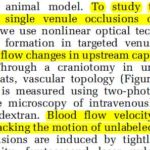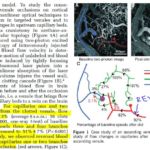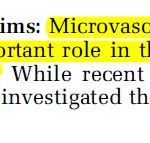Reference source/supplementary reading for lecture Your Brain on Collision Sports
- Body World Pics
- Brain Poster Session: Experimental Cerebral Ischemia – Blood Flow and Metabolism
- Microvascular Flow Physics
MICROVASCULAR FLOW PHYSICS / TIE INTO ZETA POTENTIAL
Capillaries measure 5-10 μm in diameter and enable the interchange of water, oxygen, carbon dioxide, and many other nutrient and waste chemical substances between blood and surrounding tissues.[3] True capillaries branch mainly from metarterioles and provide exchange between cells and the circulation. The internal diameter of 8 μm forces the red blood cells to partially fold into bullet-like shapes and to go into single file in order for them to pass through. Continuous capillaries have a sealed endothelium and only allow small molecules, like water and ions to diffuse. There are those with numerous transport vesicles and tight junctions and those with few vesicles and tight junctions. Fenestrated capillaries have pores in the endothelial cells (60-80 nm in diameter) that are spanned by a diaphragm of radially oriented fibrils and allow small molecules[1] and limited amounts of protein to diffuse. Sinusoidal or discontinuous capillaries are special fenestrated capillaries that have larger openings (30-40 μm in diameter) in the endothelium to allow [[red blood cell]s and serum proteins to enter.
THINK ‘LEAKY’
http://www.wikidoc.org/index.php/Intercellular_space










This is the right website for anybody who hopes to understand
this topic. You know so much its almost tough to argue with you (not that I actually will need to…HaHa).
You certainly put a new spin on a subject which has been discussed for
ages. Wonderful stuff, just excellent!
Oh my goodness! Awesome article dude! Many
thanks, However I am having issues with your RSS. I don’t know the reason why I can’t join it.
Is there anybody getting similar RSS issues?
Anyone who knows the answer can you kindly respond?
Thanx!!